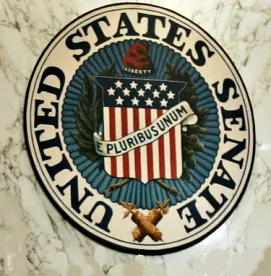On Wednesday, Senator Coon—of 101 hearings fame—and five co-sponsors introduced the Stronger Patents Act in the Senate (“Support Technology & Research for Our Nation’s Growth and Economic Resilience”). About 22 of the bill’s 40 pages involve amendments to IPR, PGR and ex parte rexamination that limit appeals and clarify overlapping court and PTO actions. These provisions have been ably summarized by Joshua Rich in a post at PatentDocs, but there are other interesting amendments to 35 U.S.C. so I thought I would start toward the last half of the bill.
Section 106 of the bill, entitled “Restoration of Patents as Property Rights,” amends section 283 to require that a court that finds infringement to presume that further infringement would cause irreparable injury and that remedies available at law are inadequate to compensate for that injury. These are the circumstances that encourage the court to issue an injunction against the infringer.
Section 42 of 35 U.S.C. would be amended to end USPTO fee diversion into the general fund by providing that any fees collectable by the Director shall be “available to the Director” and used to operate the PTO. Remaining unobligated funds are to be maintained in the “USPTO Innovation Promotion Account.”
Section 123(d) would be amended to clarify that a mircoentity includes an applicant who receives the majority of his income for a institution of higher education, or applicant has, or is under an obligation to assign, grant or convey a license or other ownership interest to said institution or the applicant is the institution or the applicant is a 501(c)(3) “nonprofit organization” that holds title to the institution’s patents “for the purpose of facilitating commercialization of the technologies” of the IP.
The bill establishes a pilot program whereby no fewer than six district courts will receive one additional law clerk or secretary who is tasked, with the assistance of the Federal Judicial Center, with helping the court “develop expertise in patent and PVPA cases”…”for the purpose of expanding the [patent cases pilot program] to address special issues raised in patent infringement suits against individuals or small business concerns.”
The bill introduces Title II—”Targeting Rouge and Opaque Letters” and defines “Unfair or Deceptive Acts or Practices in Connection with the Assertion of a United States Patent” (section 202). The bill makes it an “unfair or deceptive act or practice,” as defined by the ITC, to send written communications that the recipient is or was an infringer of “the patent” and bear liability or owe compensation to another, if the sender, in bad faith (high probability of deceit and intentional avoidance of the truth—defined in more detail in the bill—sends communications regarding 15 specific assertions regarding infringement, licensing and prior suits, or failure to identify the sender.
These bad acts or failures to act are a laundry list of the approaches patent trolls use to intimidate recipient targets or to mask their identities. Bad acts include falsely representing that sender has the right to enforce the patent, that a civil action has been filed against the recipient or other parties, that recipient will be sued, that third parties have taken licenses, including failure to disclose that the other licenses are not to the allegedly infringing acts, that recipient’s alleged infringement has been investigated by sender or that sender has filed an action that sender knew had failed.
A sender cannot seek compensation for infringement of a claim that has been held unenforceable or invalid, acts by recipient after the patent has expired or recipient’s acts that the sender knew were properly licensed.
A sender in bad faith, cannot fail to include the identity of the person asserting the right to license or to enforce the patent, including ultimate parent entities. The patent asserted to be infringed upon must be identified, as must the product or activity of the recipient alleged to be infringing. The name of a contact person must be given to the recipient.
While the sender can argue that any of these acts or failures to act was due to an honest mistake, enforcement is by the FTC and the fines can be as high as $5 million.
Section 204 preempts State laws regarding “transmission or contents of communication relating to the assertion of patent rights,” but does not preempt other State laws relating to state trespass, contract or tort law. The FTC can intervene in suits brought by States and, if the FTC has instituted a civil suit, the State cannot begin an action under section 202.
While I am sure that there are freedom of speech and commerce clause arguments to be made, this bill elevates its prohibitions to the level of shouting “fire!” in a crowded theater. Combined with the proposed traffic laws meant to limit the use of multiple IPR filings, and their associated appeals at every turn in the litigation road, this seems to be a reasonable attempt to untangle the tortuous relationship between district court litigation and post-grant PTO proceedings.
Senator Coons played an important role in the recent Senate subcommittee hearings on the misguided expansion of patent ineligibility under Section 101. He may have found this part of the Patent Statute to be easier to untangle than defining a “natural phenomenon” or an “abstract idea” but I hope that this issue remains on his IP to-do list.


 />i
/>i


